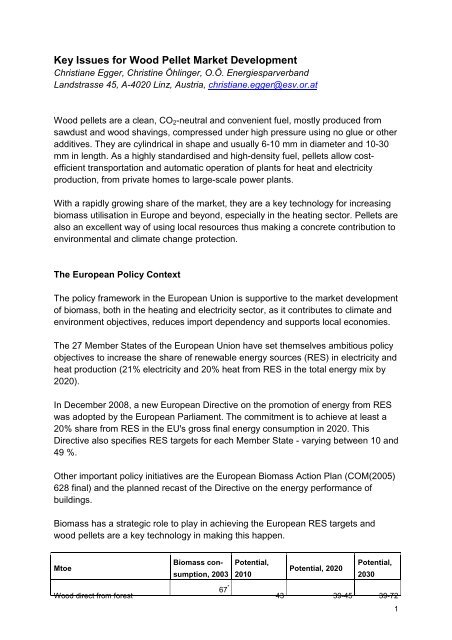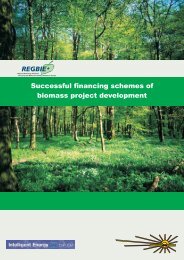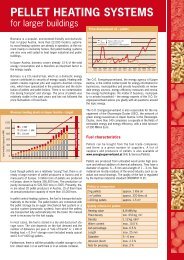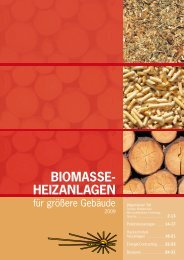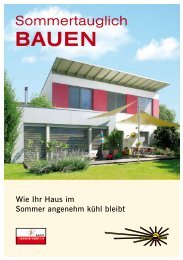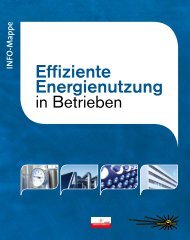Key Issues for Wood Pellet Market Development
Key Issues for Wood Pellet Market Development
Key Issues for Wood Pellet Market Development
You also want an ePaper? Increase the reach of your titles
YUMPU automatically turns print PDFs into web optimized ePapers that Google loves.
<strong>Key</strong> <strong>Issues</strong> <strong>for</strong> <strong>Wood</strong> <strong>Pellet</strong> <strong>Market</strong> <strong>Development</strong><br />
Christiane Egger, Christine Öhlinger, O.Ö. Energiesparverband<br />
Landstrasse 45, A-4020 Linz, Austria, christiane.egger@esv.or.at<br />
<strong>Wood</strong> pellets are a clean, CO 2 -neutral and convenient fuel, mostly produced from<br />
sawdust and wood shavings, compressed under high pressure using no glue or other<br />
additives. They are cylindrical in shape and usually 6-10 mm in diameter and 10-30<br />
mm in length. As a highly standardised and high-density fuel, pellets allow costefficient<br />
transportation and automatic operation of plants <strong>for</strong> heat and electricity<br />
production, from private homes to large-scale power plants.<br />
With a rapidly growing share of the market, they are a key technology <strong>for</strong> increasing<br />
biomass utilisation in Europe and beyond, especially in the heating sector. <strong>Pellet</strong>s are<br />
also an excellent way of using local resources thus making a concrete contribution to<br />
environmental and climate change protection.<br />
The European Policy Context<br />
The policy framework in the European Union is supportive to the market development<br />
of biomass, both in the heating and electricity sector, as it contributes to climate and<br />
environment objectives, reduces import dependency and supports local economies.<br />
The 27 Member States of the European Union have set themselves ambitious policy<br />
objectives to increase the share of renewable energy sources (RES) in electricity and<br />
heat production (21% electricity and 20% heat from RES in the total energy mix by<br />
2020).<br />
In December 2008, a new European Directive on the promotion of energy from RES<br />
was adopted by the European Parliament. The commitment is to achieve at least a<br />
20% share from RES in the EU's gross final energy consumption in 2020. This<br />
Directive also specifies RES targets <strong>for</strong> each Member State - varying between 10 and<br />
49 %.<br />
Other important policy initiatives are the European Biomass Action Plan (COM(2005)<br />
628 final) and the planned recast of the Directive on the energy per<strong>for</strong>mance of<br />
buildings.<br />
Biomass has a strategic role to play in achieving the European RES targets and<br />
wood pellets are a key technology in making this happen.<br />
Mtoe<br />
Biomass consumption,<br />
2003<br />
Potential,<br />
2010<br />
Potential, 2020<br />
Potential,<br />
2030<br />
<strong>Wood</strong> direct from <strong>for</strong>est<br />
67 * 43 39-45 39-72<br />
1
(increment and residues)<br />
Organic wastes, wood industry<br />
residues, agricultural and food<br />
processing residues, manure<br />
100 100 102<br />
Energy crops, from agriculture 2 43-46 76-94 102-142<br />
TOTAL 69 186-189 215-239 243-316<br />
*This figure includes 59 Mtoe of wood and wood wastes; 3 Mtoe of biogas; and 5 Mtoe of municipal<br />
solid waste.<br />
Source: EU biomass production potential, Biomass Action Plan COM(2005) 628 final (in Mtoe)<br />
<strong>Wood</strong> <strong>Pellet</strong> Use and Qualities<br />
In Europe, wood pellets are mainly used as follows:<br />
• <strong>Pellet</strong> stoves: these are often modern appliances in an attractive design, bagged<br />
pellets are normally used. They are ideal <strong>for</strong> milder climates or as a heating source<br />
additional to an electric, gas or oil heating system. The largest market in Europe is<br />
Italy.<br />
• <strong>Pellet</strong> boilers:<br />
These are fully-automatic central heating systems <strong>for</strong> residential heating with bulk<br />
delivery of pellets. Different to the US, pellets are usually delivered by a special<br />
tank truck and blown into the storage systems. The pellet boilers are connected to<br />
the pellet storage by an auger (mechanical fuel feeding system) or a suction<br />
system (pneumatic system), from which the pellets are transported fully<br />
automatically into the boiler. No manual work is necessary <strong>for</strong> the fuel supply,<br />
making such systems as user-friendly as a gas or an oil heating system. The heat<br />
distribution system within the building uses water. Well-developed markets pellet<br />
central heating systems are <strong>for</strong> example Austria, Germany, Sweden or France.<br />
While the investment costs <strong>for</strong> such systems are about 30 % higher than <strong>for</strong> an oil<br />
heating system, fuel costs are considerably lower and there is a good return on the<br />
investment.<br />
• District heating and power plants:<br />
Mainly in Northern European countries (such as Sweden or Denmark), pellets are<br />
also used to fire biomass district heating or CHP (combined heat and power<br />
plants). An increasing market is also co-firing where pellets are used to substitute<br />
coal in large power plants, <strong>for</strong> example in Belgium, the Netherlands and the UK.<br />
Modern pellet stoves and pellet boilers require pellets in a highly specified quality.<br />
Austria was the first country to adopt a pellet standard (the Austrian ÖNORM M<br />
7135) which tremendously helped the market development. From the very beginning,<br />
only pellets in a clearly defined quality were on the market, allowing boiler<br />
manufacturers to develop very low-emission appliances.<br />
2
Several other European countries followed by introducing a quality standards <strong>for</strong><br />
wood pellets(such as the German DIN plus standard), currently a European standard<br />
is under development, its adoption is anticipated <strong>for</strong> 2009.<br />
Quality characteristics<br />
requirements<br />
diameter<br />
5-6 mm<br />
length<br />
max. 25 mm<br />
density at least 1.12 kg/dm 3<br />
water content at most 10 %<br />
amount of ash at most 0.5 %<br />
heating value<br />
at least 18 MJ/kg<br />
dust at most 2.3 %<br />
additives at most 2 %<br />
For comparison<br />
2 kg <strong>Pellet</strong>s ~ 1 litre oil<br />
1 m³ pellets ~ 320 litre oil<br />
1,000 kg pellets ~ 1.5 m³<br />
The technical fuel requirements <strong>for</strong> pellets according to ÖNORM M 7135<br />
Production and consumption of wood pellets<br />
In the last years, pellet production facilities have boomed all over the world,<br />
especially in Europe and in Northern America.<br />
The production capacity in all EU 27 is estimated at about 9 million tons (2007),<br />
globally it might be as much as a 12-14 million tons capacity.<br />
Leading EU pellet producing countries are Sweden (1.7 million tons), Germany<br />
(900,000 tons) and Austria (800,000 tons). Sweden and Austria both have been<br />
leading pellet countries since the beginning of the pellet market development in<br />
Europe in the mid-nineties. Increasing production capacities can also be found, <strong>for</strong><br />
example, in France, Spain, Latvia, Estonia and Poland. Russia has significantly<br />
increased its production capacities, from 50,000 tons in 2005 to 550,000 tons in<br />
2007, nearly all of it <strong>for</strong> export. Canada’s plants produced about 1,335,000 tons in<br />
2008.<br />
In terms of pellet consumption, Sweden, Germany and Austria are in the lead in<br />
Europe, closely followed by France were a rapid market development took place in<br />
recent years. Italy has become one of the most important pellet consumers due to the<br />
increasing number of installed pellet stoves (about 800,000 stoves).<br />
The pellet consumption in Europe presently amounts to about 6 million tons per year.<br />
3
On the Northern American market, about 2,300,000 tons of pellets were consumed<br />
in 2008 (about 2,000,000 in US).<br />
Important pellet exporters are Canada and Russia, large pellet importers are<br />
Denmark, Italy, Belgium and the Netherlands.<br />
With an increase of global trade, a world-wide certification <strong>for</strong> the sustainable<br />
production of pellets will become increasingly important.<br />
<strong>Pellet</strong> raw materials<br />
For the future market development, the issue of pellet raw materials and its price will<br />
be crucial. Presently, the main raw material <strong>for</strong> pellets is sawdust, however current<br />
sawdust resources are becoming increasingly utilised. One solution would be<br />
importing saw dust from China, Russia or Southern America. However, concerns<br />
about sustainable <strong>for</strong>estry and long transport routes might lead to a loss of consumer<br />
trust and support by public policies.<br />
Another option is to use other raw materials. Agricultural products and residues, such<br />
as straw, hay, miscanthus or energy crops - so-called agri-pellets - have been at the<br />
centre of attention of the pellet community in the past years. Un<strong>for</strong>tunately, all of<br />
them are much harder to burn cleanly than wood, there<strong>for</strong>e - due to the emission<br />
legislation - significant product development is required be<strong>for</strong>e mass use in most<br />
European countries will be possible.<br />
Another promising option are other <strong>for</strong>est residues, such as wood chips or log wood,<br />
and short rotation <strong>for</strong>ests. First experiences are already available in Sweden and Italy<br />
where poplar or willow are planted.<br />
Conflicts of use<br />
Raw material <strong>for</strong> wood pellets is not available infinitely, at least not at relatively low<br />
costs. Fluctuations in sawdust availability and price are also caused by the<br />
construction industry - if this sector needs less material, this leads to lower activity in<br />
the wood working industry which results in lower quantities of sawdust being<br />
produced and available <strong>for</strong> pellet production.<br />
There<strong>for</strong>e, there is a debate in the pellet community where wood pellets should be<br />
used best in the future: in small installations to heat homes, schools and shops or in<br />
large power stations where they can substitute significant quantities of coal.<br />
There are those who argue that wood pellet heating is one of the few options<br />
available <strong>for</strong> 100 % CO 2 neutral heating of buildings. User-friendliness, low fuel costs<br />
4
and the fact that it is an environmentally friendly solution have already convinced ten<br />
thousands of consumers in Europe to make the investment in a pellet stove or boiler.<br />
And there are the others stating that pellets, when co-fired in power stations, allow <strong>for</strong><br />
quick substitution of fossil fuels at very low investment costs.<br />
One answer to this debate would be a strong increase in global trade. However,<br />
wood pellets which travel around half the globe have lost some of their environmental<br />
advantages and will be a lot less attractive to homeowners and to public programmes<br />
which financially support the investment. However, the environmental balance looks<br />
much better <strong>for</strong> large power stations in the vicinity of ports.<br />
The price challenge<br />
The pellet price is another decisive factor <strong>for</strong> further market opportunities, both in the<br />
heating of buildings and in electricity production. As it is young and still comparatively<br />
volatile, the pellet market has less ability to balance the impact of market turbulences<br />
than larger and more mature markets.<br />
One example is the price crisis which hit a number of European markets in 2006.<br />
After several years with stable pellet prices which did not follow the price fluctuations<br />
of heating oil and natural gas, a pellet price peak shocked consumers and excited<br />
potential pellet producers.<br />
The rapidly growing demand, a very cold winter and the lack of stock keeping<br />
contributed to a very high pellet price, up to twice the price of one heating season<br />
be<strong>for</strong>e. In the following winter - which was unusually warm - pellet stove and furnace<br />
sales declined dramatically in a number of European countries. This created a very<br />
difficult situation <strong>for</strong> all those businesses which had invested in new production<br />
facilities <strong>for</strong> pellets or pellet appliances.<br />
In the meantime the situation calmed down and pellet prices came down to previous<br />
levels again, however, consumer confidence in the fuel suffered.<br />
Presently the pellet market development in Europe is again very positive and <strong>for</strong><br />
2009 in Germany and Austria <strong>for</strong> example a growth rate of about 25-30% is <strong>for</strong>eseen.<br />
Future solutions will have to take the different interests of different actors on the<br />
pellet market into account:<br />
- suppliers of pellet raw material are interested in high prices <strong>for</strong> the sawdust<br />
- producers of pellets are interested in high fuel prices<br />
- producers of pellet boilers want stable pellet prices and competitive heat costs<br />
5
- public bodies who provide investment subsidies <strong>for</strong> pellet installations in many<br />
European countries have also an interest in a stable price situation on the pellet<br />
market.<br />
Summary<br />
<strong>Wood</strong> pellets have a number of advantages compared to other wood biomass fuels.<br />
As a condensed fuel, transportation is cheaper and less cumbersome. Due to the<br />
high degree of standardisation, they allow <strong>for</strong> a very low-emission combustion, even<br />
in very small appliances, comparable to the emission of modern gas or oil heating<br />
appliances - but of course, without emitting CO 2. Already today, pellets are a very<br />
competitive fuel in the heat market and have become a mainstream fuel in a number<br />
of European countries. If the price and the raw material challenges can be mastered,<br />
wood pellets will be one of the key technologies in achieving climate policy<br />
objectives.<br />
Upper Austria - the region of wood pellet heating<br />
In Upper Austria, a region (federal state) in the North of Austria with about 1.4 million<br />
inhabitants, renewable energy sources (RES) provide 30% of the primary energy<br />
consumption of which 14% comes from biomass. The share of renewable energy<br />
sources in the heating sector is over 40%. The region has made the commitment that<br />
by 2030 all space heating and electricity will come from renewables.<br />
Biomass, and especially wood pellets, have an important role in achieving the<br />
ambitious target. Presently, more than 16,000 wood pellet central heating<br />
installations are in operation – most of them in homes but increasingly also in larger<br />
commercial and public buildings. <strong>Pellet</strong> stoves are very popular in the thousands of<br />
low energy homes.<br />
The pellet market development is supported by comprehensive programmes well<br />
adapted to the changing needs of the market and ranging from training of installers to<br />
campaigns or consumer advice. Financial incentives are available to home owners<br />
and businesses willing to install a pellet boiler.<br />
<strong>Pellet</strong>s are also an important economic factor, leading European boiler producers<br />
have their head quarters in the region. Based on the successful home market they<br />
are exporting pellet technology all over Europe and are about to export also to the<br />
US market. A network of companies active in the field of energy efficiency and<br />
renewable energy sources – the Oekoenergie-Cluster (OEC, www.oec.at) – which is<br />
managed by the O.Oe. Energiesparverband, the regional energy agency – supports<br />
companies in their business development. 148 companies are partners of the<br />
network achieving a turn-over of 1.6 billion Euro and having 4,500 employees.<br />
6
The European <strong>Pellet</strong> Conference, 25-26 February 2009 and 3-4 March 2010,<br />
Wels/Austria<br />
With more than 600 participants every year, the European <strong>Pellet</strong> Conference held in<br />
Wels has become the largest annual pellet event in the world. The international pellet<br />
community gathers in Austria to discuss technological innovation, market trends and<br />
new cooperation projects with experts from all over the world. It also provides an<br />
insight into the current developments on the leading European and international<br />
pellet markets.<br />
The European <strong>Pellet</strong> Conference is held in parallel to the "Energiesparmesse", a<br />
trade show dedicated to renewable energy sources and energy efficiency with nearly<br />
100,000 visitors every year and more than 100 exhibitors showing pellet related<br />
products.<br />
The European <strong>Pellet</strong> Conference is part of the World Sustainable Energy Days which<br />
is one of the largest annual conference in the field of energy efficiency and<br />
renewable energy sources in Europe. The World Sustainable Energy Days includes<br />
different conferences which present the latest technology trends, outstanding<br />
examples and European strategies. In 2008, the conference attracted more than 950<br />
participants from 61 countries. More in<strong>for</strong>mation is available at www.wsed.at<br />
<strong>Pellet</strong> Central Heating Systems<br />
A pellet central heating system can directly replace oil or gas boilers. It is fully<br />
automated: not only lights the system itself automatically and feeds fuel from the<br />
pellet storage at the rate of the heat demand, but the boiler also cleans itself every<br />
day ensuring continued efficiency. Automatic wood pellet heating systems are<br />
available in a range of sizes to suit anything from a small, energy-efficient house to a<br />
large office or business premises.<br />
A typical wood pellet boiler <strong>for</strong> residential homes requires normally a boiler room of<br />
2m x 2m. A typical pellet store also requires a minimum space of 2m x 2m and can<br />
be installed in a separate room within the building or in a converted garage, in a shed<br />
or in a special container. Automatic wood pellet heating systems are designed <strong>for</strong><br />
bulk fuel supply. This method of delivery is common in mature pellet markets,<br />
providing cheaper bulk purchase prices, dust-free filling and is time-efficient <strong>for</strong> the<br />
home owners. A tank truck blows the fuel in the storage room, from where it is carried<br />
by an auger to the boiler. In most situations the pellet store requires refuelling only<br />
once or twice a year.<br />
7


